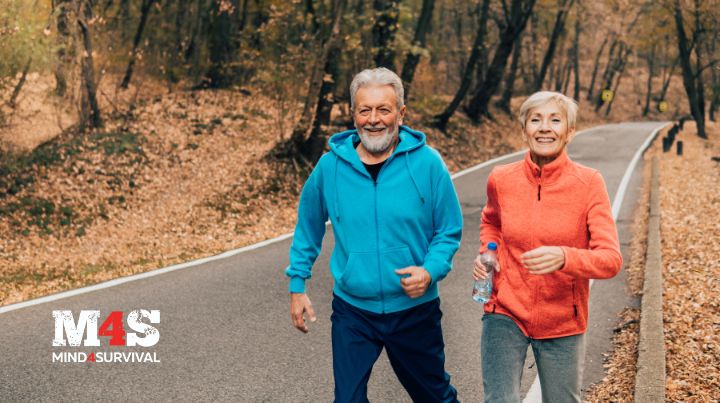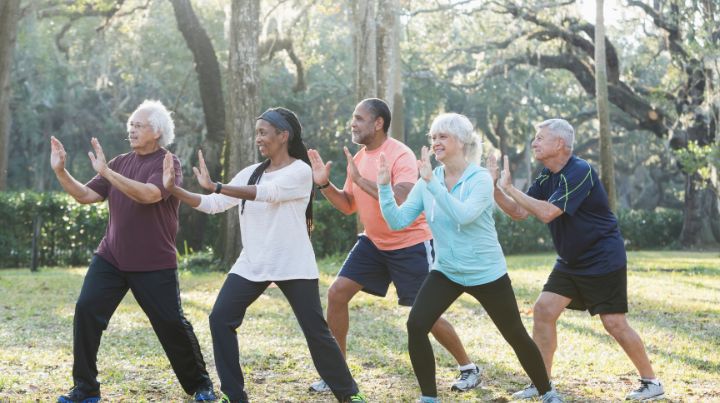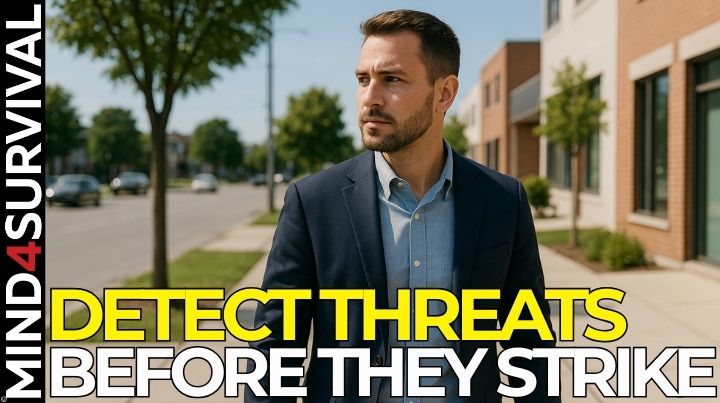Prepping for Aging: How to Maintain Your Health

The recent passing of a family member due to complications from a common household accident had me reflecting even deeper on the subject. According to the statistics, these occurrences are responsible for many incapacitations and deaths, particularly of elders.
“About 16 out of 100 people were injured, and about 1 out of 1,890 died from a preventable injury in the home and community venue in 2021” [SOURCE]
And whether things hit the fan in the next week, month, year, or decade – or never – every single one of us will have to contend with something inevitable: getting old. As we age, deterioration accelerates, and that has an impact on our quality of life.
Being an aging prepper can be even more challenging.
I can tell for myself. However, the aging rate varies significantly between individuals. Genes matter, of course, but lifestyle also plays a significant role. The question then becomes what we can do to slow down, stall or even revert this process to reduce susceptibility and vulnerability in the later stages of life.
Talking about it, it's never too late to start working towards a healthier post-60 life, but as we enter the forties, things start biting us in the ass faster. So the old adage of “the best time to plant a tree is ten years ago, the second best is today” applies. The sooner we start and the more we dedicate to it, the greater the benefits.
No Downsides, Lots of Upsides
- Working the body and mind is the best investment in preparation, regardless of context and circumstances.
- We're taking action on one of the few things we control (ourselves).
- It's a time-proven way to ensure a more independent, joyful, productive, and healthy aging.
- Keeps us away from harmful, negative thoughts and media manipulation and more exposed to the outdoors (fresh air, sun, nature, active people, etc.).
- It can be a way to socialize and spend quality time with friends and family.
- Helpful and valuable whether SHTF or not
Some Considerations
I decided to address the abilities individually – balance, reflexes, flexibility, etc. – to bring awareness to each. There's no need for specificity, though, as just staying active will help improve most physical and mental functions concomitantly.
There are no silver bullets nor shortcuts; however, when someone asks me for a complete anti-aging activity, I recommend practicing a martial art. Boxing, Jiu-Jitsu, Judo, Karate, and others work all systems simultaneously: reflexes, coordination, balance, muscles, everything. As a bonus, they also boost confidence and self-reliance.
Pilates and Yoga come second, in my opinion, though these won't work cardio or self-defense capacity. Other than that, the usual warnings and advice apply:
- Always consult with a doctor before engaging in any physical activity.
- Variety helps keep motivation, but discipline is required for long-term persistence. If stuck, take a break but don't slack.
- Develop routines that make programs sustainable and accessible when traveling or not at home.
- Some activities can be done at home, or a public park, while others may require special equipment and professional supervision, particularly those involving weights.
Finally, it's a good idea to take a test for each ability/skill once a year or every two years to establish a baseline and track improvement (or detect deterioration). After three or four of these tests, if you stick to the program consistently, you'll develop body knowledge and self-awareness to evaluate yourself.
Balance
The ability to balance is essentially an innate response in young, healthy adults. However, the sensation of balance gets impacted by slow aging-related changes such as weak or rigid muscles, slower reflexes, and deteriorating eyesight.
Balance issues can also result from specific medical conditions, such as inner ear abnormalities, neuropathy, and irregular heartbeats. The same is true for numerous drugs and alcohol. Perhaps it's unsurprising that at least one in three seniors falls annually. Falls can cause limitations or even death.
Unsteady equilibrium can start a downward spiral. People frequently start to move less throughout the day and voluntarily reduce their activity. As a result, stability deteriorates, balance-related muscles weaken even more, and unsteadiness increases. As well as falls, fear of falling exists.
Core and leg strengthening exercises help maintain or improve balance. Pilates, Yoga, stretching, and Tai Chi (among other martial arts) are excellent and also improve other abilities, as I mentioned.
Muscles
The importance of stronger muscles as we age can't be overstated. Lifting weights is a great way to prevent injuries, create stronger joints and denser bones (see below), and build an overall more balanced body. Strong muscles warrant autonomy and mobility, improve immunity, and reduce the risk of various diseases, from diabetes, osteoporosis, cardiovascular and even Alzheimer's.
But there's more, a lot more. Besides helping with motor functions, muscles act as a “reserve of health” to be used later in life. They help balance the body's glucose level and store proteins, antibodies, and other nutrients vital for the body.
When I hit 40, I increased my resistance training a lot. Now past 50, I'm lifting even more in load and weekly sessions. I'm not trying to get jacked or anything, the reason I'm doing that is because I've seen the difference in the quality of life of 60+ people who've lifted heavily and people who haven't, and it's night and day, so I know what I want for myself.
Bones
Osteoporosis is a medical condition in which the bones become brittle and fragile from density loss. It affects both men and women, and it's more common in people after 50. Various factors can contribute to osteoporosis: genetics, diet deficiencies, medical history, and other consumption and lifestyle choices.
Though osteoporosis gets the most attention, osteopenia is another condition where bone density becomes borderline. It's relatively common in competitive swimmers and cyclists. Though not as critical as osteoporosis, unfortunately, it's usually diagnosed (or suspected) in case of an accident – though it'll show in bone density tests. Osteopenia can be reversed with exercises (vigorous walking and stationary jumping, among others) and changes in diet.
Treatment of osteoporosis is also done by combining weight-bearing exercises and diet adjustments. However, some new medications have been proving very effective to revert or at least stop the condition from advancing. And let's not forget the importance of sunlight in synthesizing vitamin D, which is essential to calcium fixing.
Cardio
High-intensity training is fantastic but can become more challenging and less pleasant as we age, even for those who've done HIT for most of their lives. Not to mention the cumulative effects of impact (running) and crash risks (cycling).
There are less strenuous ways to reap many of the same benefits with Zone 2 cardio. A brisk walk is more manageable and can be done anywhere, almost year-round, with little equipment and low risk. These are why it's the #1 physical activity I recommend in my Street Survivalism: A Practical Training Guide book.
Cycling is an excellent leg workout that improves reflexes, coordination, etc., but the risk of crashing is more significant, and the consequences can be dire. Swimming works the cardio system and adds some full-body resistance workout without impact, but it requires a pool. Vigorous dancing has a social element added. Trekking and backpacking are also tremendous and put us in contact with nature.
Aiming for 3 to 5 hours of moderate-intensity aerobic activity a week, spread out over 3 or 4 days, is ideal. Maybe more if you are accustomed (or the doctor has cleared). As with everything else, consistency and discipline are key, so try not to skip more than two sessions at once and think long-term.
Reflexes
By strengthening the connection between the body and brain, it's possible to improve reaction times. That can make a noticeable difference in the ability and time to react to stimuli and events, which helps significantly in various areas of everyday life.
One form is through drills and repetitions. Athletes perform these over and over as a way to perfect movements and also improve reaction time. Start with slower exercises focusing on form, then speed up as you advance.
Some experts also recommend visualization exercises, in which the action and movements are visualized repeatedly and differently. The brain and nervous system respond to the stimulus, and meditation and focus exercises can strengthen neural connections.
Cognitive training exercises (CTEs) are a relatively new concept showing some results, and many variations can be done at home. Finally, a balanced lifestyle with enough sleep, a decent diet, and good hydration are essential to keep the brain, muscles, and other body systems in good condition and ready to fire up.
Flexibility
Flexibility is the capacity to extend the range of motion in a joint fully. In the average population, 25% to 30% of overall flexibility is typically lost by age 70. This drop has numerous reasons, from tendons and ligaments becoming stiff to a decrease of collagen fibers and elastin, cartilage degradation, ligaments, and so on.
These alterations can be significantly slowed down, in general, by physical activity. Numerous studies have demonstrated that physically active people, even as they age, have a much more comprehensive range of motion than sedentary people. Stretching is the best way to improve flexibility, avoid injuries and reduce motion pain.
The Brain
The science of “brain gymnastics” is vast, and there are many ways to keep cognitive functions, memory, and creativity in top shape as we age. Learning a new language, a new skill, or doing art (painting, music, etc.) is the equivalent of weightlifting for the brain. Math, sudoku, crosswords, puzzles, and reading are also great. CTEs can help here as well.
Good habits such as a healthy social life, a balanced diet, quality sleep, and physical exercises complement the above to keep the brain healthy and working. Other activities such as meditation and mindfulness add up, too, as does having a purpose in life – a work, career, or hobby that extends past retirement. The healthiest and happiest 60+ people I know are still working relatively hard and setting goals despite reaching retirement age.
Weight
The older we get, the more our nutrition has to tighten up. Our diet is, in great part, responsible for how we feel and how we perform. The available material and data on dieting are so vast and varied that it's impossible (and impractical) even to try to cover it helpfully in a short post.
It's also a field fraught with myths, disinformation, pitfalls, and propaganda from “experts” trying to sell something, so choose your sources wisely. If in doubt, keep it simple, as it makes it hard to go wrong:
- Avoid extreme diets and miraculous fads. Moderation without radicalism. That means you can eat anything, just not everything. We are what we eat but also what we don't eat.
- I'm also a big proponent of intermittent fasting. It works, but you must learn how to do it right, so check with a specialist for a program tailored for you.
- Whole foods are more nutritious. Basic, simple, and true.
- There's this widespread idea that eating more healthily is expensive. While it's true that processed and ultra-processed food is cheaper and more readily available, especially in urban centers, the biggest obstacle to a healthier diet isn't cost but time and dedication. Fact: buying the ingredients and cooking your food is cheaper and more nutritious than eating industrialized junk.
- We must proactively go after the best ingredients and prepare our food if we want to eat better without necessarily paying a fortune. There's also the matter of discipline, as just cutting some of the junk and increasing the quantity of nutrient-dense food can make a big difference.
Final Considerations: Improvement or Decline
Sure enough, some of us struggle with pain, limitations, and deficiencies, whether chronic or temporary. I have my share of broken bones and torn muscles coming back to haunt me as I race past 50, but I try not to let that stop me from staying as active as possible. Ask yourself what you can do to improve your situation, and don't be discouraged by obstacles.
Actions can compound over time, and there's a positive mental effect to just doing something and staying active, no matter how small. We see it constantly with people overcoming severe physical and mental conditions, so this is no motivational BS talk but fact.
Almost everything is a habit; therefore, we can make or break the ones we want if we dedicate ourselves to it. Never underestimate how much you can change by doing something, even a little, daily. Keep in mind that consistency is the key to keep advancing.
Additional Resources:
- SHTF Tasks for All Ages and Abilities
- Fitness As A Survival Skill
- Six Safe Hiking Tips to Enjoy the Outdoors More
- The Ultimate Survival Gear Handbook by Fabian Ommar
Related Articles
FREE Guide
Read the Best Seller
Join Mind4Survival
Stay informed by joining the Mind4Survival! 100% Secure! 0% Spam!
Affiliate Disclosure...
Mind4Survival is a free, reader-supported information resource. If you make a purchase through our link, we may, at no cost to you, receive an affiliate commission.
Do You Want To Be Ready No Matter What?

Download our free 39-page guide with interactive, 7-Day Emergency Kit Checklist and take the first step toward real preparedness.
- Know exactly where to start.
- Save time and money.
- How-to build a complete Basic Emergency Kit.
- Level up your safety and security.
Join Mind4Survival
Stay informed by joining the Mind4Survival! 100% Secure! 0% Spam!








Good one 🙂
Good article.
I will turn 70 in a few months and, while I was active walking 7 days a week for a distance of about 6 miles, in the past 10 years or so have gotten sloppy. I bought a small treadmill for walking, and wanted to know if you could recommend any dvd’s to match up with your suggestion. I have a few for core, strength, walking, tai chi, balance, stretching, but wanted one for lifting weights, and a martial art (I don’t think tai chi is one that works all systems, but I’m not sure.) I also have a bike and plan to ride at least 4 miles a week.
I’d also like to get my workroom finished so I could do my hobby: making beauty, health and cleaning recipes to sell.
Thank you for the post.
Thanks Carol, great to know you´re getting active again. I prefer to listen to podcasts and audiobooks when walking, perhaps you wanna try that instead of DVDs and see if you like it too. As for Tai Chi, I´ve practiced it for years and still do some routines to work balance, breathing and concentration. It´s awesome because balance is very important as we age. It won´t make much for cardiovascular capacity but it´s great for everything else. Besides, cardio can be improved on the treadmill, climbing stairs, swimming or riding the bike. I love Tai Chi and can´t recommend enough. Saty safe.